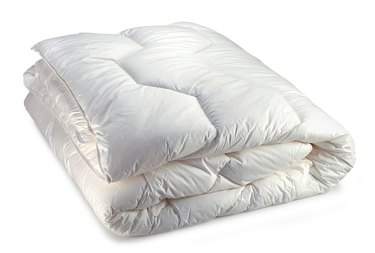
A down comforter, or duvet, is a bed-size envelope of sheeting fabric stuffed with duck or goose down and, sometimes, feathers. It insulates in warm and cold weather and is so light it practically floats over you on the bed. Buying a down comforter is a bit more complex than picking a size and color. The duvets come with different fill powers for levels of warmth, higher thread counts to keep feathers from poking through -- more expensive -- and stitching in various patterns. Baffle and box are distinctions that affect performance.
Box-Stitch Down Duvet
Video of the Day
A duvet that is stitched through all the fabric to create a quilt of fluffy boxes provides even insulation over the entire bed. The feathers and down can't migrate to the ends, corners or one side of the duvet in response to sleep patterns or basic wear over time. But a simple box stitch, particularly if the boxes are small, compresses the two sides of the fabric envelope and doesn't allow the down to reach its full loft inside the case. This cuts down on the insulation and is an option only for a lighter, summer-weight comforter. The larger the boxes in a box-stitched duvet, the greater the loft and the more warmth you can expect.
Video of the Day
Baffle-Stitch Means Better Lofting
A baffle-style comforter has little walls of fabric sewn to the top and bottom fabric layers between the box-shaped chambers that hold the fulling. The dividers allow the down and feathers to fluff up higher with lots more air space between them, resulting in better insulation. Baffle construction maximizes the loft and efficiency of the down. The comforter holds its original shape, and you stay toasty on a cold winter's night. There are no "thin" spots or flat areas where the down has departed for another section of your duvet. Baffle construction adds a bit more to the cost of the duvet, but it protects your long-term investment -- and your frozen toes. Sometimes this style of stitching is called baffle-box.
Adjustable Cozy
Two duvet stitching patterns you may find on your quest for the perfect down comforter are decorative and adjustable. A ringed stitch is curvy and open, so it partly inhibits the down shifting but lets you shake the filling to areas where it will provide greater warmth. The karo or diamond pattern is partly open; it looks rich and luxurious, but it is designed to let you fluff the down to where you need it the most. Neither of these styles give you consistent all-over heat, but, if your shoulders freeze and your feet sweat, or if you have the world's warmest back and popsicle toes, you can customize the fluff in your down comforter so you sleep better.
Preferred Options
The pretty pattern on the duvet that determines how warm you'll be is just one choice you'll have to make. Fill power is the amount of down per cubic inch -- higher fill power means greater warmth, and you can customize fill power for mild, medium or frigid climates. The filling itself dictates price and comfort. The down from mature geese is superior to that from smaller ducks, and both are better at insulation than heavier feathers. Pure down is the priciest: The preferred down from the large North Sea Eider duck is the best, most expensive fill you can buy. Mixed down and feathers, in various proportions, are cheaper alternatives that may well do the job. Pick your stitching and configure the rest of your options for your ideal down comforter.